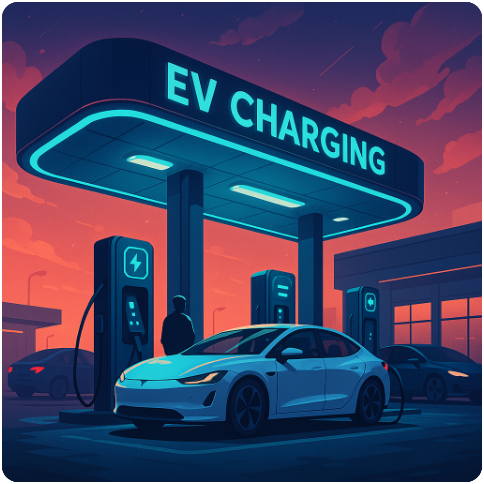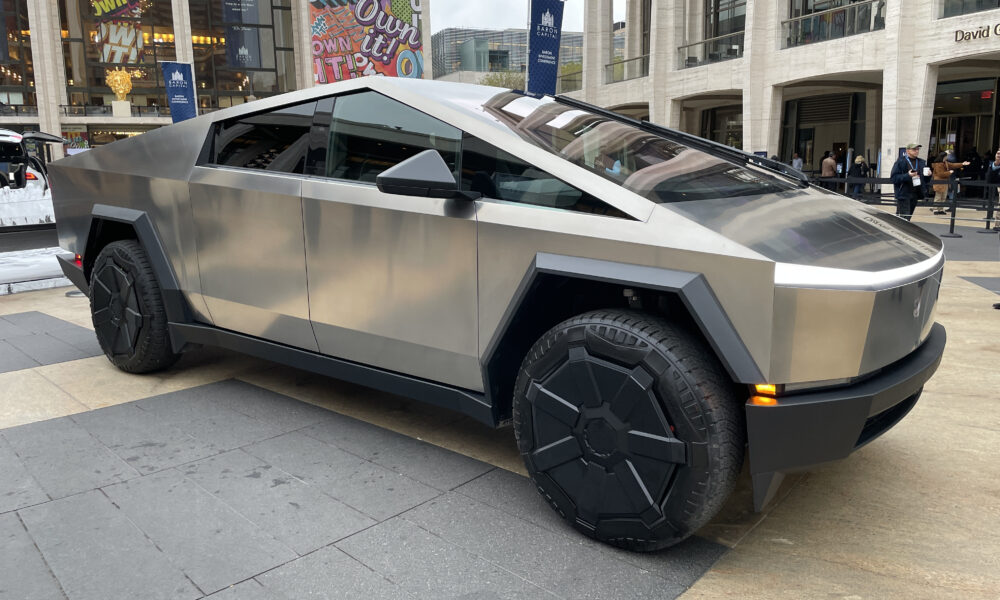Category: Electric Vehicles
EV Charging May Be Coming to a Gas Station Near You
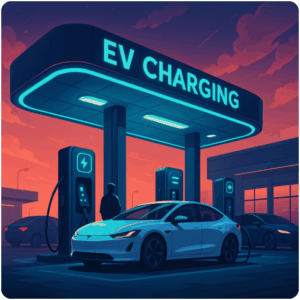 Of the many concerns that keep car buyers from taking the plunge into EV ownership, access to fast, on-the-road charging remains at the top of the list. While Tesla has largely solved this problem through its fast charger network, the other 50 percent of EV owners in the U.S. must resort to a hodgepodge of charging pumps, many of which are unreliable, inconveniently located, and take too long to charge.
Of the many concerns that keep car buyers from taking the plunge into EV ownership, access to fast, on-the-road charging remains at the top of the list. While Tesla has largely solved this problem through its fast charger network, the other 50 percent of EV owners in the U.S. must resort to a hodgepodge of charging pumps, many of which are unreliable, inconveniently located, and take too long to charge.
To be sure, the problem is at least partially solved for some EV owners, who can charge their car overnight in their own garage. Yet the problem remains for EV owners that live in townhomes, condominiums, and apartments, without a dedicated garage.
Nouria, a chain of combination gas stations and convenience stores, which operates in more than 180 locations throughout the Northeast, has taken steps to solve the problem. In addition to the typical array of beef jerky sticks available at most gas stations, Nouria goes several steps further, providing an eclectic mix of merchandise, including stuffed animals, Ashton Churchill cigars, healthy snacks, and of course, potato chips and candy bars. As an added convenience, a Dunkin’ Donuts concession provides chocolate glazed, jelly, and butternut donuts, along with blueberry munchkins.
Its filling station in Framingham Massachusetts, located twenty miles from Boston as the crow flies, provides five stalls with two pumps on each side, where up to ten drivers can fill their gas tanks at once. In an accessible area adjacent to the filling pumps reside two ChargePoint Level 3 EV chargers, ready to provide a relatively quick electron boost. Over time, as I’ve routinely stopped for a Dunkin’ butternut donut, I’ve seen Rivian R1Ts, Volkswagen ID.4s, a few Hyundai Ioniq 5s, a couple of Honda Prologues, and several Ford Mustang Mach-Es take their turns in the charging bays.
Recently, I chatted with a couple who were on their way back to their home in Western Massachusetts. They were happy to have found the Nouria station on their Rivian app, which enabled them to charge their R1T pickup truck in something like 20 minutes, though I don’t recall how much range they had left on their battery before stopping at the station. And they didn’t have to drive far out of their way to find it, as the Framingham location is close to the Massachusetts Turnpike entrance. For what it’s worth, they were so enthusiastic about their Rivian that they volunteered to show me the ample trunk space under the front hood, where the engine normally sits in a gas powered pickup truck.
Gas nozzles outweigh EV chargers by a ratio of 5:1 at this particular filling station, yet while on a recent stop, I saw just two cars filling up for gas, while both chargers were occupied. As I washed down my Dunkin munchkin with a swig of coffee, I thought: could this be a glimpse into the future?
Less than two percent of all cars in Massachusetts are EVs, but EVs now account for 12 percent of all new cars purchased in the state, according to the Alliance for Automotive Information. Nouria has placed a bet that the numbers will rise, and perhaps over time more EV chargers will be added to more of its locations. In the meantime it will be interesting to see if others in the convenience store and gas station business begin to add EV chargers. The pace of EV adoption and demand for charging services will no doubt dictate the decision.
The Cure for EV Range Anxiety Is Coming

By Ben Z. Rose
Dec 27, 2023, 2:00 am EST
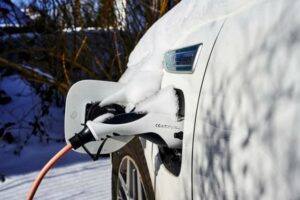 Of all the obstacles to broader adoption of electric vehicles, the lack of publicly available car chargers is the one cited most frequently. If we are to believe industry pundits, traditional car drivers are scared to death of buying an EV for fear of draining the battery and getting stuck on the side of the road of some backwoods hamlet, or worse, getting ensnared in city traffic. The fear of an empty battery has led to a condition commonly referred to as range anxiety. And it persists, despite the industry’s best efforts to treat it.
Of all the obstacles to broader adoption of electric vehicles, the lack of publicly available car chargers is the one cited most frequently. If we are to believe industry pundits, traditional car drivers are scared to death of buying an EV for fear of draining the battery and getting stuck on the side of the road of some backwoods hamlet, or worse, getting ensnared in city traffic. The fear of an empty battery has led to a condition commonly referred to as range anxiety. And it persists, despite the industry’s best efforts to treat it.
Great strides have been made to extend EV battery life in the last few years. It’s unusual today for an EV to have a charging range of less than 250 miles, with 300 miles or more increasingly common. This is farther than many cars and pickup trucks can drive on a single tank of gas. Moreover, the number of publicly available charging stations is rising, with the ratio of EVs to charging ports falling rapidly. Even fast chargers are now rising as a portion of charger infrastructure. Fast chargers are like highway gas stations for EVs—they let drivers pull in and quickly refill most of their charge.
In Massachusetts, for example, EVs make up about 1% of all registered light vehicles. The state has one fast charger for every 75 EVs, while the ratio of registered light vehicles to gasoline pumps is one to 196 (assuming 10 pumps per gas station). And more innovations are in the works: Members of AAA can now obtain roadside EV charging services in 15 cities around the U.S., including West Springfield, Mass.
Yet there remain real reasons to worry about taking an EV out on a road trip. First of all, the number of fast chargers is greatly skewed in favor of urban, versus rural areas. Most charging stations have only one or two charging ports, and since even fast charging can take 15-45 minutes depending on the battery, lines can form quickly. That can get stressful when many charging facilities are unmanned and fully self-service. By contrast, there is hardly ever a line at the local gas station, or at a Cumberland Farms, which may have as many as 16 pumps working at once. It’s also nice to know that if you have a problem with your credit card, there’s a person on premise in the form of a cashier or attendant that can resolve it. Being able to buy a bag of peanuts, a cup of coffee, or use the restroom, is of course a bonus.
This stands in contrast to many EV chargers, which have difficulty reading a credit card. This assumes that the charger is in working order when you reach it. Far too many are not. And getting to one is not an easy feat either, especially when it’s located away from a main highway, tucked away in the back of a motel, school, or even a shopping center. Tesla drivers have it easier, with access to a more-reliable, national network. But drivers of EVs from one of the automakers also need to worry whether their EV will work with the available charger’s plug. No one ever needs to worry about whether a gasoline pump will fit into their tank.
Fortunately, help is on the way. Tesla’s clever decision to open a portion of its fast charger network (and thus defray the costs of operating it) to other manufacturers, including GM, Ford, Volvo, Mercedes-Benz, Nissan, Honda Motor, BMW, Toyota, Rivian Automotive, and several others, will help to alleviate the problem. Tesla has also made its charging standard available to charger manufacturers. This could both increase the availability and reliability of chargers, in much the same way that Microsoft’s decision to open up its Windows user interface to other software makers made it easier to write software for a larger audience.
Indeed, the time will come—perhaps only in a few years—when EV Range Anxiety can not only be treated, but cured. Until that day arrives, those still on the fence about buying an EV can focus on other pet peeves, such as the still-high unsubsidized price of most EVs, the poor performance of in-car electronics, fear of losing battery life in cold weather, and, for some models, the high cost of repairs.
Guest commentaries like this one are written by authors outside the Barron’s and MarketWatch newsroom. They reflect the perspective and opinions of the authors. Submit commentary proposals and other feedback to ideas@barrons.com.
Bauhaus Meets Blade Runner: Tesla’s New Cybertruck
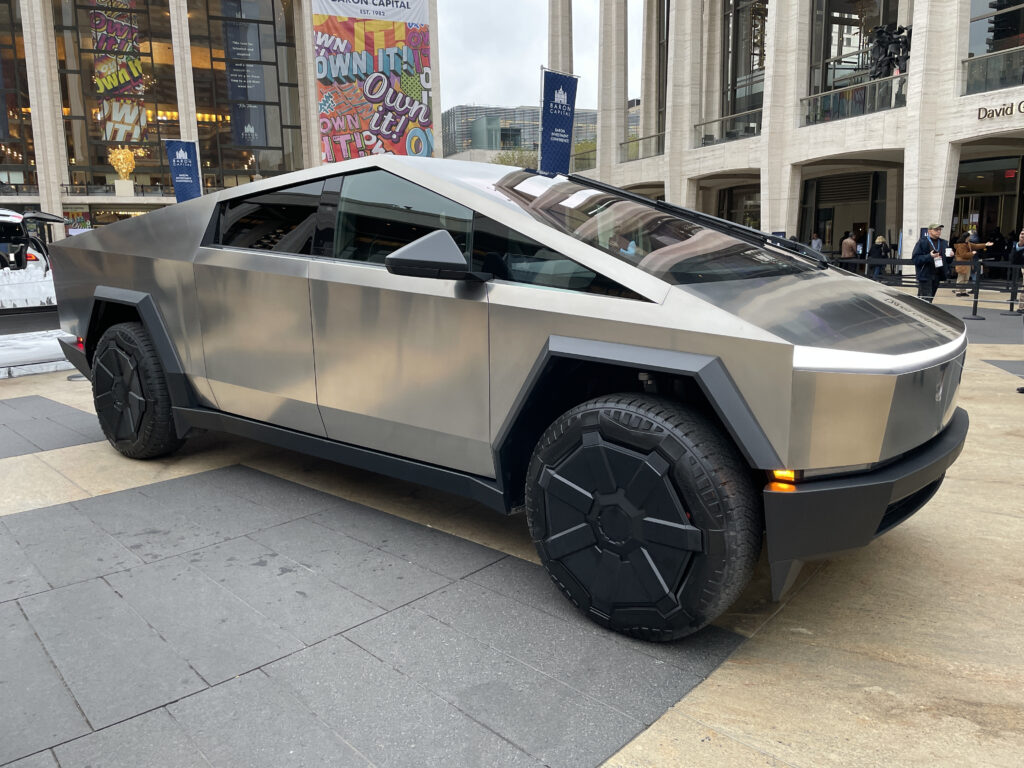 Arriving in time for the end of tailgating season, the Cybertruck, with its futuristic—if controversial—angular design, will certainly be a head-turner as deliveries begin. Originally unveiled in 2019 as a bullet-proof prototype that was not bullet-proof, the Cybertruck’s unique design aesthetic is a blend of Bauhaus and Blade Runner. The sports car-like pickup truck presents myriad manufacturing and component sourcing challenges, as stainless steel is difficult to form, bend, cut and weld. It is also difficult to maintain a uniform appearance. According to an internal email written by Tesla CEO Elon Musk in August of this year, “all part dimensions need to be to the third decimal place in millimeters and tolerances need to be specified in single digit microns.” As if to downplay this lofty objective, Musk went on to write, “If LEGO and soda cans, which are very low cost, can do this, so can we.”
Arriving in time for the end of tailgating season, the Cybertruck, with its futuristic—if controversial—angular design, will certainly be a head-turner as deliveries begin. Originally unveiled in 2019 as a bullet-proof prototype that was not bullet-proof, the Cybertruck’s unique design aesthetic is a blend of Bauhaus and Blade Runner. The sports car-like pickup truck presents myriad manufacturing and component sourcing challenges, as stainless steel is difficult to form, bend, cut and weld. It is also difficult to maintain a uniform appearance. According to an internal email written by Tesla CEO Elon Musk in August of this year, “all part dimensions need to be to the third decimal place in millimeters and tolerances need to be specified in single digit microns.” As if to downplay this lofty objective, Musk went on to write, “If LEGO and soda cans, which are very low cost, can do this, so can we.”
Like the original Ford Model T, the Cybertruck is available in just one color: in this case, unpainted stainless steel. Unlike any of the full-size pickup trucks available from Ford, GM, and Stellantis, which dominate the 2.5 million unit market in the U.S., the Cybertruck is, in the words of the announcer on Monty Python, something completely different.
First off, the Cybertruck looks like something that would be lowered from the Lunar Module to collect rocks on the moon, rather than a run-of-the-mill pickup truck that will haul and tow cargo for tradesmen. It remains unclear how resistant the car body will be to dings, scratches and outright dents, but we do know that ultra-hard stainless steel is difficult to repair, treat and restore to its original finish. This makes it impractical for hauling and towing construction equipment, as well as collecting moon rocks. And yet the Cybertruck is remarkably competitive with other EV pickup trucks on the market in terms of brute strength: it boasts a maximum tow capacity of 11,000 pounds, while its 2,500 pound maximum payload is almost 50 percent greater than the Rivian R1T, and a bit more than the Ford F-150 Lightning.
An important unresolved question is whether the Cybertruck will appeal to the sub-segment of the pickup truck market that is already purchasing an electric truck. If so, the numbers are not very encouraging. Of the projected 2.46 million pickup trucks that will be purchased in the U.S. this year, less than two percent, or something like 35,000 units will be either Ford F-150 Lightning or Rivian R1Ts.
Rivian has, in fact, seen its product mix shift heavily in favor of its full-size electric SUV, while Ford has announced plans to reduce its EV pickup truck volume for 2024, while also having vowed to double the number of Ford F-150 hybrid engine vehicles it intends to sell next year. All of this suggests that there may be less enthusiasm about EVs among both traditional and non-traditional buyers of pickup trucks.
Getting down the cost curve with a reasonable price for the Cybertruck will be key for Tesla to penetrate the market. Though the first wave of users is unlikely to be tradespeople, there is no reason that subsequent waves couldn’t be, given the truck’s towing and payload capacity, which is sure to improve over time. We are sure that Cybertruck version 5.0 will be quite different from previous versions.
Put differently, the more affordable Cybertruck becomes the bigger the market. At some point, though not today, the well-defined size of the pickup truck market will become relevant when the Cybertruck can breach the $50,000 or less entry level price point. Then the Cybertruck will be able to lay claim to its five-to-ten percent or more market share of the 2.5 million unit U.S. pickup truck market, which would equate to 125,000 to 250,000 annual units or more. Now it is only a question of time.
It’s Time for a Real Mustang EV
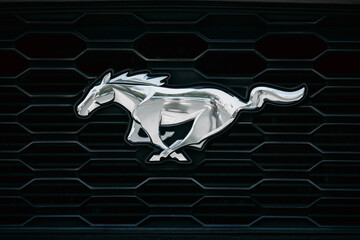 The resounding box office success of Top Gun: Maverick, in which Tom Cruise reprises his role as fighter pilot Pete “Maverick” Mitchell, is the most recent example of America’s love of nostalgia. Despite the nearly forty year interval between the two films, diehard fans of the original Top Gun and new filmgoers alike were enticed to return to the big screen.
The resounding box office success of Top Gun: Maverick, in which Tom Cruise reprises his role as fighter pilot Pete “Maverick” Mitchell, is the most recent example of America’s love of nostalgia. Despite the nearly forty year interval between the two films, diehard fans of the original Top Gun and new filmgoers alike were enticed to return to the big screen.
The Ford Motor Company has a similar opportunity to revisit the phenomenal success of the original Mustang, a two-door sports car that sold over one million units in its first two years. Named after the World War II fighter plane, and launched at the New York World’s Fair in 1964, what came to be known as the “pony car” combined the best of European styling and American ingenuity. In the new age of EVs, Ford has launched the Mustang Mach-E SUV, which carries the Mustang moniker, but, let’s face it, in no way resembles the original.
To be sure, Ford has taken strong steps to electrify its product line, as evidenced by MotorTrend’s recent unanimous selection of the Ford F-150 Lightning as Truck of the Year for 2023. But why not create a real Mustang EV, similar in body design to the one that captured the imagination of a generation of car-buyers. An authentic looking and performing Mustang would give Ford the chance to create a “two-horse” race with Tesla, whose Model 3 is the early leader in the EV passenger car category. By doing so, Ford would be making a statement that it will not cede this all-important segment as the world shifts from combustion engines to electric motors.
Rather than compete solely on the basis of safety features and battery range, Ford could bring back the original pony interior, with its alluring three-dimensional image of horses in flight. Rivian Automotive has made a minor splash in the pickup truck world with its vegan leather interior, an obvious appeal to the environmentally conscious. With vinyl records making a comeback, Ford could bring back the original vinyl interior of the Mustang, or perhaps an engineered material which does not bake or crack in the sun? And as much as many of us enjoy the utter silence of an EV motor, Ford could embed a device that simulates the growl of the Mustang engine, an option for traditional automotive enthusiasts.
And who knows? An EV incarnation of the original Mustang might be even more successful than the original. After all, the new Top Gun: Maverick achieved a 96 percent approval rating on Rotten Tomatoes, while its predecessor tallied a mere 58 percent. So too does Ford have the opportunity to create an even more popular Mustang that would reach a wider audience in a new era of consumer transportation.
Competition Heating Up in Pickup Trucks
Rivian established a first mover advantage in the electric pickup truck market when it launched the R1T in 2021. Having won the coveted Motor Trend Truck of the Year award for 2022, Rivian, we believe, held the market share lead in EV pickup trucks as of the end of 2022.
Fresh on the heels of having won the Motor Trend Truck of the Year for 2023, Ford announced on January 5th that it has sold 15,617 F-150 Lightning trucks since the vehicle was unveiled to customers in May of last year. Ford has not so quietly been claiming that in each of the last two months it has sold more EV pickups than any other manufacturer.
By the end of Q1 2023, it is likely that Ford will pass Rivian to become the overall leader in electric pickup sales in the United States. This is not necessarily surprising, as Ford’s classic F-150 has been the best-selling truck in the United States for 46 consecutive years. Importantly, Ford offers the F-150 in multiple model variants that range in price from $40K to $90K. And Ford has many years of brand equity from which to draw. Moreover, while both Rivian and Ford are relatively inexperienced at building EVs, Ford has a demonstrated ability to produce vehicles in large volumes—something that Rivian has struggled with.
Another headwind facing Rivian is the inevitable launch of Tesla’s Cybertruck. To be clear, the Cybertruck is way behind schedule, relative to original estimates provided by Tesla, but it now appears that limited production will begin this summer. Rather than go head-to-head against Rivian and Ford in the market for conventional-looking EV pickup trucks, Tesla is taking a risk with a unique body style that is sure to electrify some, yet conceivably turn-off others. The angular, space-age body of the Cybertruck is equipped to handle any type of terrain, will supposedly feature a bullet-proof body, and will be manufactured with a unique mix of light-weight aluminum and ultra-hard 30x cold-rolled stainless steel.
From what we can gather, fly-over drone footage available over the Internet of Tesla’s Gigafactory in Texas revealed the recent delivery of at least part of a 9,000-ton Giga Press, which will be used to cast aluminum parts in the first production run. Elon Musk has said the Cybertruck, when available, will be the car he drives to work in Austin. The Cybertruck has the potential to put a freeze on the electric pickup truck market, as consumers will be curious to learn more about it before purchasing a rival vehicle. This is especially true for prospective Rivian buyers who desire an elite luxury pickup truck. While a case can be made that the R1T and Cybertruck may ultimately appeal to different buyers, it is likely that consumers who are interested in the R1T would also consider the Cybertruck for similar reasons. Could this be part of the reason why Rivian stopped disclosing its backlog?
Tesla Implements Overdue Price Cuts
Rather than fight it out with the U.S. government over whether a standard Model Y is a cross-over or an SUV, which would make it ineligible for the $7,500 federal tax incentive, Tesla recently enacted over-due price cuts on the Model Y, as well as its entire product line. With a 31 percent price reduction on a base level Model Y (inclusive of the tax credit) Tesla is now better positioned to retain its leading market share of EV sales in the U.S., which currently stands at 65 percent.
The move recognizes the unsustainable 30 percent-plus rise in Tesla’s list prices over the last two years brought about by supply chain bottlenecks and component shortages coming out of the global pandemic. Rather than rely on Tesla’s generous pricing umbrella, competitors will have to follow suit. The next battleground will be the composition of battery materials and critical minerals thresholds required to qualify for the full federal credit.
At the start of the New Year, Tesla’s core EV models, the Model 3 sedan and Model Y small SUV, became eligible for a U.S. federal income tax credit for the first time in over two years.
The most important price cut was on the base-level Model Y, which was reduced from $65,990 to $52,990—a 20 percent reduction. When factoring in the $7,500 federal tax credit, the price cut amounts to a 31 percent reduction in price. At its new price point, the base level Model Y for the first time fits comfortably within the $55,000 cap for passenger cars and cross-overs.
Over the last two years, Tesla Model 3 prices rose by over 30 percent, as component shortages and supply chain bottlenecks drove prices higher both during and immediately following the end of the pandemic in the U.S. These price increases were unsustainable, and inconsistent with growing the EV market further. The new Model Y price opens up an entirely new segment of buyers unable to afford a $66,000 car, and makes Tesla’s pricing more consistent with the intent of the Inflation Reduction Act, whose goal was to stimulate demand for non-carbon emitting vehicles, while making EVs more affordable. The previous federal tax credit had income limits, and some lawmakers complained that it subsidized EV purchases only by the wealthy. With a $125,000 single tax payer, $150,000 head of household, and $300,000 joint household income limit, the new tax credit opens up the market to a new demographic that may not have considered an EV purchase previously.
It will be interesting to see whether Tesla will be able to keep up with demand. The Model Y and Model 3 together account for about 65 percent of the EV market in the U.S. At the end of 2022, Tesla was just getting started in the ramp-up of its Austin Texas factory, which was said to be producing about 12,000 Model Ys per month. In Austin, production is limited to the Model Y. The ramping of production means that Tesla will achieve greater scale economies as time progresses, particularly as component shortages and supply chain bottlenecks continue to improve.

